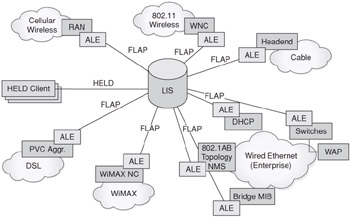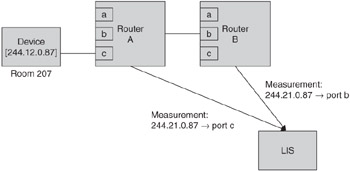Location Measurements
A location measurement is a datum that can be used to locate a device. A LIS uses measurements to determine location, and a location measurement can be used as a key into a location database, or as input to an algorithm.
A location measurement is a piece of data about a network that does not necessarily contain actual location information. Measurements of this sort hold no specific information about the network, thus the devices that provide location measurements do not need to know about location, only about the network characteristics that are important to their operation.
For instance, a wireless base station might report the strength of the radio signal it receives, or timing information-or a wired switch reports the port that traffic is routed to. Specific examples of measurements are shown in detail in Chapters 5, 6, and 7.
The Access Location Entity (ALE)
A centralized LIS provides a number of benefits, particularly for data management and client access, but its position in the network makes it unsuitable for acquiring network measurements. The Access Location Entity (ALE), by contrast, is located at the very edges of the network where it has access to the necessary information about network attachments.
The ALE is a generic label applied to a class of components that provide location measurements. The specific functions that an ALE provides depend on the type of access network, but they all have the common property of being responsible for providing location measurements. Figure 3.1 shows how ALEs from many different types of access networks can report to a single LIS. The LIS needs to understand each of these networks, but (as shown in Figure 3.1) the LIS hides this complexity by providing the same interface to its clients, irrespective of the type of access network.

Figure 3.1: Different types of ALEs for different access networks.
The concept of a centralized LIS is important to the management of the location service. From an operational perspective, management of location data is the single most complex task involved in running a location service. Storing all location data in a central repository reduces the cost of operating the service. For this reason, the ALE should have as little configuration as possible so that it requires configuration changes less often.
The exact size and form of an ALE depends greatly on the access network. An ALE can be a standalone piece of overlay hardware that reads network packets to acquire measurements, or an ALE can simply be a small software component in a network device, like an Ethernet switch, that forwards preexisting data to the LIS.
Each ALE monitors a particular network sector at a particular network point. Multiple ALEs may be required at different points of the network to provide sufficient information to determine location. The LIS is responsible for collating information from multiple ALEs.
Cost-effective ALEs will likely be overlay solutions in the short term. An overlay means that network operators can avoid the cost of purchasing or upgrading existing equipment by implementing custom-developed ALE functions that interwork with their existing equipment. However, future network equipment will need to contain an ALE function, where a small software or hardware addition provides the best engineering solution for purposes of size, performance, and functionality.
Evolution from Location in the Cellular RAN
The Radio Access Network (RAN) of a cellular network shares some of the properties of the IP access network. A server within this network performs functions similar to a LIS: a Serving Mobile Location Center (SMLC) for GSM, a Stand-Alone SMLC (SAS) for UMTS, or a Mobile Positioning Center (MPC + PDE) for IS-91/CDMA. Each of these network servers contains the necessary information and functionality to determine location information. Obviously, a cellular network uses different identifiers (MSISDN is common) to associate location information with a device rather than an IP network.
The ALE in the cellular network exists in a number of places, with the clearest analogue being the Location Measurement Unit (LMU). The LMU is analogous to an overlay ALE; additional ALE functions can also be found at other points of the network, including ALE functionality that's integrated into the BSC and BTS.
In order to determine the location of a device, the server relies on measurements from the RAN. This might be the identity of the cell site, or more detailed information about radio timing that is retrieved from the base stations within the network.
The division of responsibilities in location determination between the LIS and ALE in the IP location architecture are a clear formalization of the cellular model. The ALE is given a distinct role in this model, which further clarifies the distinction between location and other functions in the network. Figure 3.2 shows how the location determination function of a GSM SMLC talks to ALEs in the access network.

Figure 3.2: ALEs in the GSM access network (GERAN).
The LIS and ALE have clearly defined generic roles in the cellular architecture, which has lead to a few variations in the different network architectures. The LIS function is defined separately as a subtly different network node for each network type (SMLC, SAS, PDE).
Using Measurements
Location measurements can be thought of as a series of clues that can be matched to some specific data to form a chain. At the start of this chain is a device identifier (an IP address), and at the other end is a location. Location measurements form some of the links of this chain, while other links are in a database in the LIS, or are algorithms applied by the LIS. Figure 3.3 shows how this chain is formed for an Ethernet network, using one of the determination technologies discussed in Chapter 5. The IP address is linked to a MAC address by the DHCP lease query; MAC is matched to a switch and port by a Bridge MIB ALE; and the switch and port are linked to location by an entry in the LIS Database.

Figure 3.3: Location measurements are combined with a database to determine location.
Location measurements are usually pushed from the ALE to the LIS when a change is detected in the network. The LIS is then able to update location information dynamically in response to these changes. The subscription model discussed in Chapter 2 is enabled by dynamic updates.
The following example demonstrates how a location might be determined in a generic wired network. This example is simplified to demonstrate how location measurements are used; more thorough examples with real network architectures can be found in later chapters.

ALEs in each of the routing nodes provide the LIS with notifications when the network state changes. This information can be used together with information in a database to form a chain. The chain can be formed when location measurements are received from the ALEs; alternatively, the measurements can be stored and the chain formed on demand. In the following example, location measurements are stored and the location is generated when a request for the location of an IP address is submitted.
-
The LIS determines the starting point of the measurement process by finding a location measurement that includes the given IP address. A stored location measurement from Router B indicates that it can route messages for that IP address.
-
The LIS then uses the location measurement from Router B, which links the IP address to a port on the switch: Router B, port b.
-
The LIS database is then used to determine that "Router B, port b" leads to Router A.
-
A location measurement from Router A links the IP address to Router A, port c.
-
The LIS database determines that the cable plugged into port c on Router A leads to a network socket in Room 207.
The preceding example assumes dynamic updates from ALEs; however, the process could also use on-demand location measurements. If the LIS requests location measurements when it needs them, the process of location determination is very similar, except that the first step could require a search to determine where the chain begins. The FLAP protocol provides options for both dynamic and on-demand location measurements.
EAN: 2147483647
Pages: 129